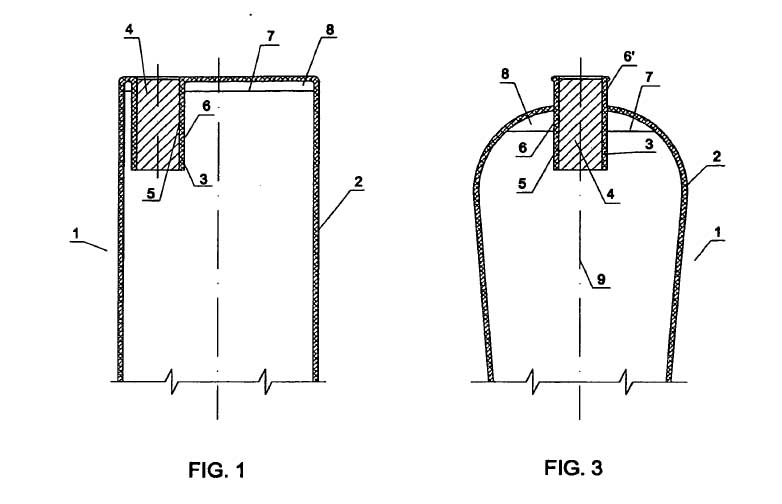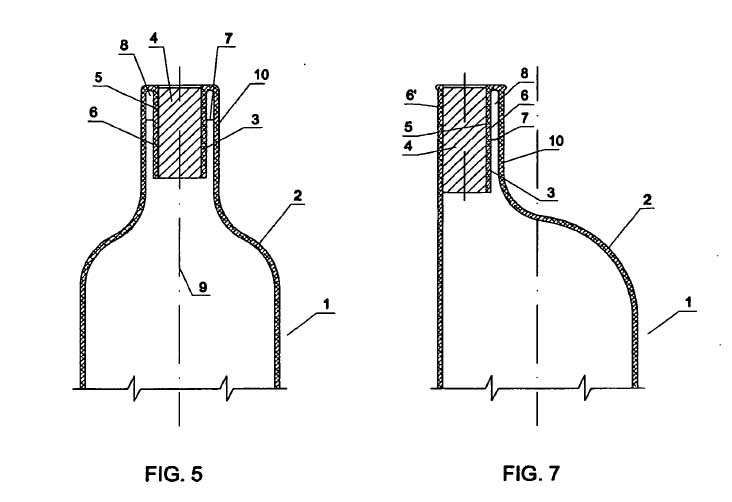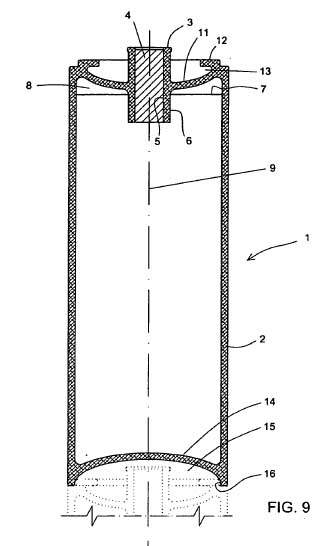“Wine Technology of the Future” is a series on The Academic Wino that features new inventions and patents that attempt to make your wine experience easier and more enjoyable. Previously on this series, we’ve introduced the “self-aerating wine bottle”; the “corkscrew with integral intelligent thermometer”; “wine dispensing and preservation device”; “multi-stream wine aerating device”; the “wine bag carrier”, the “system and method for pairing food with wine”, and most recently, the “lateral flow device for Botrytis cinerea detection”. Today’s invention is the “wine bottle with permanent contact between the wine and the cork”, invented by Gregorio Peñafiel Monteserin from La Rioja, España. The European patent was filed on February 17th, 2010, and was recently granted and published on July 10th, 2013.
According to the patent (EP 2 399 834 B1), this new type of wine bottle was designed to “allow for permanent contact between the wine contained inside the bottle and the cork, regardless of the bottle’s position, including the vertical position”.
Why does wine-to-cork contact matter?
According to some research, wine contact the cork is very important for oxygen transmission through the cork into the wine, which aids in proper wine aging and storage. If the cork is not in contact with the wine for a period of time, the cork will dry out and cause a slight shrinkage, which effectively creates a tiny space in between the cork and the neck of the bottle, rapidly increasing the amount of oxygen entering into the bottle and reacting with the wine. A little oxygen is good, but too much oxygen is bad, so it’s important to store wine bottles properly (with the wine touching the cork—best in a horizontal position) so that the cork does not dry out and increase the chance of oxidation. Also, if the cork dehydrates due to poor positioning and it is later moved back into a horizontal position, the little extra space that was created when the cork dried out and shrank will result in some of the wine leaking out, creating a big mess and ruining your wine.
So, the moral of the story is that winemakers and/or shop owners try to stress to their customers that the proper way to store wine is on its side, so that the cork is always in contact with the wine. However, the winemaker can’t guarantee this practice will actually take place, and they’ll cross their fingers that the customer will heed their advice, so that any complaints based solely on improper storage and not winemaking technique will not rear their ugly heads. I suppose customers aren’t the only ones to blame—often bottles are stored in a vertical position during the shipping process from winery to shop, thus another opportunity for cork dehydration presents itself.
Why can’t you just fill the wine up to the very top of the bottle?
At first one may beg the question of filling up the current wine bottles all the way to the top with wine. The wine will always be in contact with the cork that way, right? Well, the small air pocket that winemakers leave in the bottle is actually very important, and without it, the wine would be in whole mess of trouble. One reason why the small air pocket in the wine bottle is necessary is that the liquid inside the bottle with expand or collapse, depending upon temperature fluctuations. So, if you filled the wine all the way up to the top and did not leave a little “wiggle room”, the expansion of the wine would cause the cork to pop right out (or at least push out slightly), which I probably don’t even need to tell you is not a good thing. Also, maintaining a little bit of air contact is important in the micro-oxygenation of the wine, with is critical for proper aging and storage.
How can we fix this problem?
The author of today’s patent came up with a solution to guarantee the cork will not dry out, causing oxidative or other damage to the wine inside the bottle, but inventing a bottle that results in a cork touching wine 100% of the time, regardless of what in which position the bottle lies, while still maintaining a small pocket of air somewhere in the bottle to adjust for volume changes due to temperature.
You’ll see in figures 1,3,5,7, and 9, several different possible “layouts” of bottles that could be created to achieve the desired effect of constant contact between wine and cork while still leaving a little air pocket as described above. In essence, the design for all of them is basically the same, save for aesthetic differences. The bottle is comprised of a bottle neck that has interior walls that are touching the cork, and exterior walls that are not touching the cork BUT are still located in the bottle. With traditional bottles, you have the interior wall touching the cork, but the exterior wall is touching the outside air. In this invention, it’s as though a little pocket for air is created when the exterior walls for the neck are located INSIDE and not outside of the bottle. It may be easier to imagine this by consulting the many figures below. By filling the bottles made with this design almost to the top, the bottom of the cork will always be touching the wine, even when in the bottle is in a vertical position, and a small pocket for air is still created due to the exterior wall inside the bottle design of the bottle “neck”.
In each figure, the #6 represents the exterior wall of the bottle “neck” and the #8 represents the air pocket that is created when the bottle is filled nearly to the top. You can see that the base of the cork is well below this line every time, so each time the bottle is filled with wine, the cork will always be in contact with the liquid and a small pocket of air will still be maintained. (note: it’s important to actually fill the bottle up high, as if it’s not filled high enough, we could just run into the same cork dehydration issues as before).
According to the author of this patent, this design is guaranteed to last at least 50 years, which bodes well for those that would like to age their wines for a significant period of time.
Concluding Thoughts
I am actually intrigued a bit by this bottle design. From reading the patent, it sounds as though it may be a good option for avoiding the issues of improper storage due to positioning. Once the wine leaves the winery, there is no telling how that bottle will end up being stored, so by at least controlling for one factor, the winemaker can help reduce the chance that his or her bottle will end up going bad before its time due to avoidable improper storage positioning.
Of course, one big issue that has yet to be determined (that I know of anyway) is how much these bottles will cost, and how much extra glass is utilized to make this design. Environmentally, it’s not the best idea to increase the amount of glass used in an individual bottle, so if there is a way it can be done so that this is avoided, great. I would imagine the corking process would be the same between these bottles and bottles with traditional bottle necks, so I can’t see wineries needing to purchase new bottling equipment. On the consumer end, opening the bottle shouldn’t be any different than how corks are already removed from traditional bottle necks, though I do wonder if there would be some extra resistance due to a possible vacuum effect of the liquid directly contacting the cork when trying to remove it…not sure!
Personally, I think this new bottle design(s) is kind of interesting, and I’d like to see some more research on their effectiveness as well as ease of implementation into the wine industry.
What do you all think of this invention? Please feel free to leave your comments!
Source: European Patent EP 2 399 834 B1.




8 comments for “Wine Technology of the Future: Wine Bottle with Permanent Contact Between the Wine and the Cork”